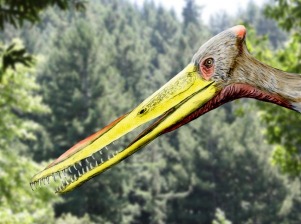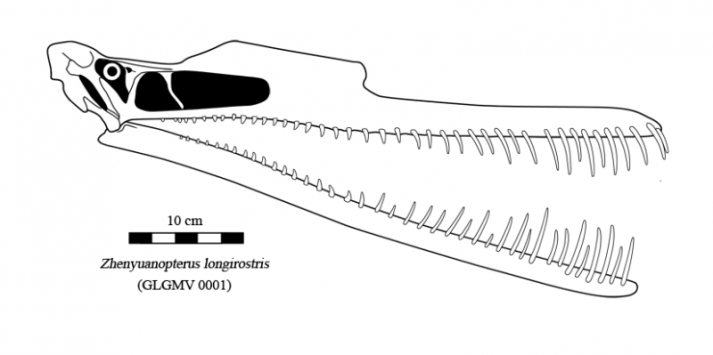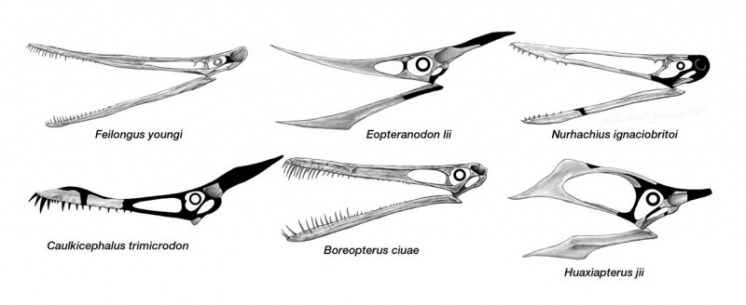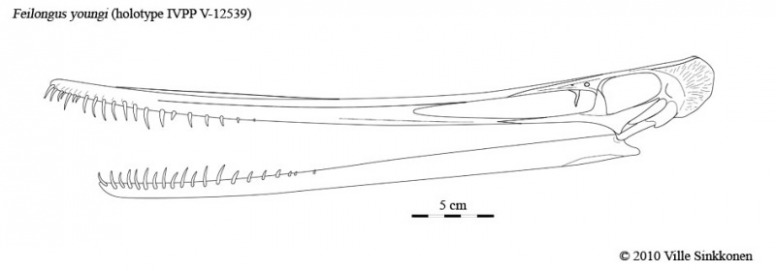Introduction

Boreopteridae is perhaps one of the least studied clades of pterodactyloid pterosaurs, right alongside Chaoyangopteridae. As of yet, these pterosaurs have all been found in the Yixian Formation of the Barremian-Aptian stages of the Lower Cretaceous, and encompass more or less three genera, each with a single species. (Image of Feilongus by Nobu Tamura).
Relations and Diversity
Boreopteridae is nested within Ornithocheiroidea, a clade that also includes the presumably scavenging istiodactylids and the fish eating ornithocheirids and pteranodontians; the mysterious pterosaur Lonchodectes is also possibly an ornithocheiroid. The first named boreopterid, Boreopterus, was once considered within Ornithocheiridae, though early it has been placed aside and considered a basal ornithocheiroid; Feilongus was first considered a ctenochasmatoid. The most recent genus, Zhenyuanopterus, was imediately considered a boreopterid. All known genera occur in the same specific location in time and space, though much like other pterosaur clades this one would have most likely been more widespread. Boreopteridae seems quite basal within Ornithocheiroidea; the presence of members if the other most basal clade, Istiodactylidae, in the same region (only Istiodactylus itself occurs outside of China) suggests Ornithocheiroidea most likely evolved in Eurasia. It is possible Boreopterus is a juvenile form of Zhenyuanopterus (see below), but this is uncertain.
Paleobiology
All known boreopterids occur in the same environment; back in the Lower Cretaceous, the Yixian Formation was dominated by an aquatic inland ecosystem, presumably a series of freshwater lakes. Vegetation suggests vast, tropical/subtropical forests, and aquatic vegetation was common in the form of horsetail beds. Because several species of animals like most mammals and lepidosaurs as well as several dinosaurs show adaptations to climbing its likely seasonal floods occured. Contemporary pterosaurs included the ctenochasmatoids Beipiaopterus, Cathayopterus and Eosipterus, the ornithocheirid Haopterus, the unclassified pterodactyloid Ningchengopterus and the anurognathid Dendrorhynchoides; with the exception of the later, all probably fed on aquatic prey or on small animals that lived along the shores. Boreopterids, like most ornithocheiroids, likely fed on fish and other aquatic prey, but how they did so was probably different from the typical strategies used by ornithocheirids and pteranodontians.
(Above, image regarding several pterodactyloid skulls by Mike Hanson, including those of two boreopterids; compare the long, thin teeth of Boreopterus and the short, hook like teeth of Feilongus with the more conventional fish eater teeth of the ornithocheirid Caulkicephalus or the short, flesh cutting teeth of the istiodactylid Nurhachius, two other ornithocheiroids.)
Ornithocheiroid pterosaurs have different teeth regarding their clades; ornithocheirids, being fish eaters, possess typical piscivore teeth for reptiles, with sharp, long teeth at the front of the jaws and shorter but similar teeth more at the back of the jaws (some lack the later), a feature also shared with some other pterosaurs like rhamphorhnychids; istiodactylids, being inland scavengers, had short, blade like teeth to cut flesh, and pteranodontians lacked teeth completly. Boreopterids have a dentition akin to that of a piscivore, but its quite unusual; in both Boreopterus and Zhenyuanopterus the front teeth are longer and thinner than those of other piscivore pterosaurs, and following them there's the shorter, albeit stronger, teeth, which in Boreopterus are very short; in Feilongus there's thin, hooked teeth at the front of the jaws, and no teeth in the back of the jaws.
Ornithocheiroid pterosaurs have different teeth regarding their clades; ornithocheirids, being fish eaters, possess typical piscivore teeth for reptiles, with sharp, long teeth at the front of the jaws and shorter but similar teeth more at the back of the jaws (some lack the later), a feature also shared with some other pterosaurs like rhamphorhnychids; istiodactylids, being inland scavengers, had short, blade like teeth to cut flesh, and pteranodontians lacked teeth completly. Boreopterids have a dentition akin to that of a piscivore, but its quite unusual; in both Boreopterus and Zhenyuanopterus the front teeth are longer and thinner than those of other piscivore pterosaurs, and following them there's the shorter, albeit stronger, teeth, which in Boreopterus are very short; in Feilongus there's thin, hooked teeth at the front of the jaws, and no teeth in the back of the jaws.

(Picture of a Zhenyuanopterus skull by Ville Sinkkonen, showing the typical boreopterid dentition)
Appearently, the long, thin front teeth were too fragile to stab large fish, forcing the animals to opt for smaller prey; this was only noted with the discovery of Zhenyuanopterus, but the similar dentition of Boreopterus and Feilongus makes it pretty obvious the same applied to them. Being incapable of sustaining themselves on individually caught small prey (specially the 4 meter wingspan Zhenyuanopterus), most likely these pterosaur could had fed by trapping schools of small fish with their teeth, a similar style of hunting to that of certain ctenochasmatoids like Gnathosaurus. An argument against this would be the presence of less teeth than in forms like Gnathosaurus, though they could have had a pouch like in pelicans. The back teeth could be used in the manipulation of individual fish caught, with Feilongus having lost them. The later has a longer upper jaw than lower jaw, a feature also seen in Pteranodon; this would have made the stereotypical hunting method associated with pterosaurs, snatching prey on the wing, quite hard, in addition to the already fragile teeth. Boreopterids certainly fed on the water surface rather than on the air, much like modern aquatic birds; while water bourne take off in pterosaurs hasn't been studied in detail, take off from the shallows or from the shores would of course be possible. Its worthy to note Boreopterus and Zhenyuanopterus have fairly deep jaws when compared to ctenochasmatoids like Gnathosaurus; this could possibly meant the teeth are well rooted in the skull, or that the rostrum was simply deep for display reasons as in birds like toucans.
Appearently, the long, thin front teeth were too fragile to stab large fish, forcing the animals to opt for smaller prey; this was only noted with the discovery of Zhenyuanopterus, but the similar dentition of Boreopterus and Feilongus makes it pretty obvious the same applied to them. Being incapable of sustaining themselves on individually caught small prey (specially the 4 meter wingspan Zhenyuanopterus), most likely these pterosaur could had fed by trapping schools of small fish with their teeth, a similar style of hunting to that of certain ctenochasmatoids like Gnathosaurus. An argument against this would be the presence of less teeth than in forms like Gnathosaurus, though they could have had a pouch like in pelicans. The back teeth could be used in the manipulation of individual fish caught, with Feilongus having lost them. The later has a longer upper jaw than lower jaw, a feature also seen in Pteranodon; this would have made the stereotypical hunting method associated with pterosaurs, snatching prey on the wing, quite hard, in addition to the already fragile teeth. Boreopterids certainly fed on the water surface rather than on the air, much like modern aquatic birds; while water bourne take off in pterosaurs hasn't been studied in detail, take off from the shallows or from the shores would of course be possible. Its worthy to note Boreopterus and Zhenyuanopterus have fairly deep jaws when compared to ctenochasmatoids like Gnathosaurus; this could possibly meant the teeth are well rooted in the skull, or that the rostrum was simply deep for display reasons as in birds like toucans.
(Above Feilongus skull by Ville Sinkkonen; note the thin, hooked teeth, the longer upper jaw and the small sagittal crest)
Within Boreopteridae two members have a crest: Zhenyuanopterus and Feilongus, the first having one akin to that of ornithocheirids in the upper jaw but back in the base of the rostrum and possibly also a small sagittal crest while the later has just a small sagittal crest; Boreopterus has none. It is possible however that, like in several pterosaurs, the crests could have been larger in life, having keratin extensions; much like Pterodactylus, Boreopterus could have had a crest made only of keratin. In life, this animals would had been social as in most pterodactyloids, gathering in flocks in the lakes that would once become the Yixian Formation, feeding on the abundant fish schools in flocks. Much like other pterosaurs, they probably buried their eggs in the sand, gathering in large groups in the shores to keep predators at bay. Whereas pterosaurs took care of the eggs or not is unknown, but the juveniles wouldn't need much attention, since as in all pterosaurs they are assumed to have been capable of flight since after being born. Spending energy in search of food, they likely had a slow growth rate, taking years to reach sexual maturity and, afterwards, maximum size. It is likely that Boreopterus is actually just a juvenile form of Zhenyuanopterus, but this hasn't been officially suggested. It would make sense however, since the existence of two species occupying a similar ecological niche would result in a lot of competition.
Within Boreopteridae two members have a crest: Zhenyuanopterus and Feilongus, the first having one akin to that of ornithocheirids in the upper jaw but back in the base of the rostrum and possibly also a small sagittal crest while the later has just a small sagittal crest; Boreopterus has none. It is possible however that, like in several pterosaurs, the crests could have been larger in life, having keratin extensions; much like Pterodactylus, Boreopterus could have had a crest made only of keratin. In life, this animals would had been social as in most pterodactyloids, gathering in flocks in the lakes that would once become the Yixian Formation, feeding on the abundant fish schools in flocks. Much like other pterosaurs, they probably buried their eggs in the sand, gathering in large groups in the shores to keep predators at bay. Whereas pterosaurs took care of the eggs or not is unknown, but the juveniles wouldn't need much attention, since as in all pterosaurs they are assumed to have been capable of flight since after being born. Spending energy in search of food, they likely had a slow growth rate, taking years to reach sexual maturity and, afterwards, maximum size. It is likely that Boreopterus is actually just a juvenile form of Zhenyuanopterus, but this hasn't been officially suggested. It would make sense however, since the existence of two species occupying a similar ecological niche would result in a lot of competition.
History
Because only three genera have been found, little is known about the evolutionary history of these animals; occuring in a single lagerstattën fossil site, either their remains haven't been preserved elsewhere or their range was incredibly limited. The lifespan of the group doesn't seem have been very long occuring for a few million years, unless the remains of other members of the group hadn't been preserved; their extinction most likely resulted from competition with ctenochasmatoids, which led a similar lifestyle. The competition between ornithocheiroids and ctenochasmatoids isn't really surprising; as the boreopterids may show, both groups had occupied similar niches occasionally, with Cearadactylus as a large fish hunter occuring alongside ornithocheirids.


